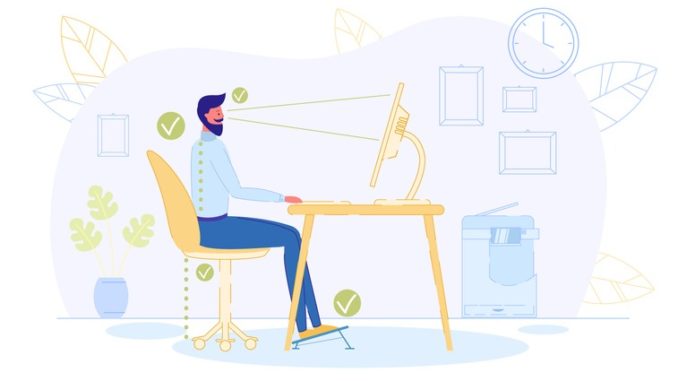
Hear the word ‘posture’ and you’ll instinctively pull your shoulders back and stand a few centimetres taller. It’s a reflex reaction, like when someone talks about head lice and you immediately want to scratch. But can you improve your posture by default, not just when you’re reminded?
CREDIT: This is an edited version of an article that originally appeared on Huffington Post
Physiotherapist Sammy Margo says good posture is all about maintaining good alignment, which basically refers to how our head, shoulders, spine, hips, knees and ankles line up with each other. Exercises like pilates and yoga can improve core strength, she says, enabling you to hold yourself in a better position, but there are also small changes you can incorporate into your daily routine that’ll make a big difference.
“Not only does [good posture] make you look better, and reduce back pain, it makes you project better and feel better – it makes the world feel like a better place,” Margo tells HuffPost UK. “I think it’s not only physical, there’s a huge mental side to it, too.”
Posture can be divided into three aspects: sitting, standing and lying down. “All three of them need to be considered for good posture,” says Margo.
Sitting
Margo’s simple trick for sitting better is ‘BBC”,’which stands for ‘bum back (in) chair’. Remembering this should stop you slumping forwards or to one side as frequently. Ciaran Keen, an osteopath at the Centre for Health and Human Performance, adds that if your job requires long stints of sitting, being a fidget isn’t always a bad thing.
“Adopting the same posture day in, day out, can overstretch muscles and ligaments around the spine, which means muscles have to work harder than usual,” he says. This can result in the typical ‘tight shoulder feeling’ if the chin is constantly forward. “Changing position frequently allows different joints, ligaments and muscles to take the load off your body.”
If you have a desk job, Ciaran advises sitting close to the table with your screen at eye level and your mid-back supported. “This helps keep the chin more tucked so the levator scapulae [muscle at the back and side of neck] and upper traps [upper back muscles] are less overstretched, which are the main culprits for upper back and shoulder tension,” he says.
For those who have multiple screens, aim to use them equally, or switch the one you rely on every week to give your neck a break from looking in a certain direction, he adds. Both Margo and Ciaran also recommend switching between standing and sitting throughout the day if you have access to a standing desk or work shelf; the key message is to keep moving.
Standing
Technology is often blamed for our sedentary lifestyles but, if used smartly, it can actually improve our posture by encouraging us to move around more, says Margo. “Instead of typing, I use more dictation software now,” she says. “Even just using Siri instead of typing can mean you’re more able to move around.”
Mobile ‘phones are just that, mobile. “They are designed to be moved around, so why aren’t we walking and talking more? Every time you’re on a ‘phone call which doesn’t require you to write anything down, get up and move .”
Margo advises looking out for flat walls. Whenever she sees a wall, she stands up against it – whether she’s chatting to friends or clients. “Put your heels up against the skirting board and line yourself up against the wall,” she says. “It’s quite shocking how quickly that makes you realise that you’re actually walking around slumping.”
When walking about, Margo recommends adopting a posture she’s named ‘The Prince Charles’. “Interlink your fingers behind your back and walk around – like Prince Charles does, with his hands behind his back,” she explains.
Switching up your shoes can also improve your posture by ensuring you’re not in one fixed position. “Low shoes all the time are bad, and high shoes all the time are bad – doing a blend of both is a good thing,” Margo says. “This might mean walking to work in your trainers and doing the working day in a shoe with a slightly higher heel.”
If you find yourself standing fairly still for a long time, such as in a queue or in a job like hairdressing, Margo advises being mindful of where you’re taking your weight. “Bad posture often happens when you’re taking your weight through the front of your feet,” she explains. “You want to bring your weight back into your mid-foot, just in front of your ankles. That’s where the load should be travelling down.”
Lying down
How you sleep will impact your posture, so it’s important to find a position that enables you to drift off, but which also feels supported. Our bodies are all different, so there’s no ‘set way’ to sleep for better posture, says Margo, but the majority of people will find sleeping on their sides most comfortable. “If you wake up with aches and pains, or you’re a bit stiff in the morning, that’s a sign things aren’t right,” she adds.
Mattresses can lose their firmness, and fail to support your body properly, after around eight years, so Margo advises investing in a new one if you’ve had yours for a while. Another fast solution can be to try sleeping with a pillow between your legs to raise your hips more comfortably.
If you start the morning pain-free, you’ll be more inclined to keep active throughout the day!
Don’t forget to follow us on Twitter, or connect with us on LinkedIn!

Be the first to comment